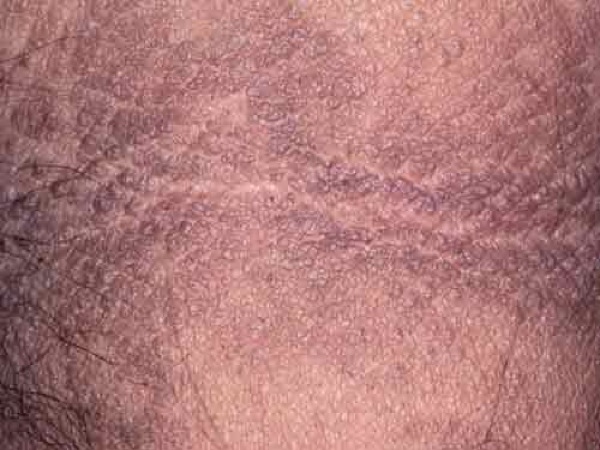Acanthosis nigricans: Difference between revisions
Kiran Singh (talk | contribs) |
|||
| Line 234: | Line 234: | ||
</gallery> | </gallery> | ||
====Pseudoacanthosis Nigricans==== | |||
=====Neck===== | =====Neck===== | ||
<gallery> | <gallery> | ||
Revision as of 18:15, 10 October 2014
| Acanthosis nigricans | |
 | |
|---|---|
| Acanthosis nigricans |
Editor-In-Chief: C. Michael Gibson, M.S., M.D. [1]; Associate Editor-In-Chief: Ogheneochuko Ajari, MB.BS, MS [2], Cafer Zorkun, M.D., Ph.D. [3], Jesus Rosario Hernandez, M.D. [4]
Overview
Acanthosis nigricans is a brown to black, poorly defined, velvety hyperpigmentation of the skin, usually present in the posterior and lateral folds of the neck, the axilla, groin, umbilicus, and other areas. Acanthosis nigricans generally occurs due to insulin spillover (from excessive production due to obesity or insulin resistance) onto the skin which results in abnormal skin growth The most common cause of acanthosis nigricans is insulin resistance, usually from type 2 diabetes mellitus.Involvement of mucous membranes is rare and suggests a coexisting malignant condition.[1]
Causes
Common Causes
- Insulin resistance
- Diabetes mellitus
- Obesity
- Drug-induced
- Gastric cancer
- Idiopathic
- Polycystic ovary syndrome
Causes by Organ System
| Cardiovascular | Congenital generalized lipodystrophy type 1, congenital generalized lipodystrophy type 2 |
| Chemical / poisoning | No underlying causes |
| Dermatologic | Peroxisome proliferator-activated receptor disorders, melanoma, Beare-Stevenson cutis gyrata syndrome, hyperpigmentation, congenital generalized lipodystrophy type 1, congenital generalized lipodystrophy type 2 |
| Drug Side Effect | Glucocorticoids, growth hormone therapy, insulin , niacin , oral contraceptives, protease inhibitors |
| Ear Nose Throat | No underlying causes |
| Endocrine | Acromegaly, Donohue syndrome, prediabetes, hypothyroidism, Addison's disease, hyperandrogenism, Bangstad syndrome, Cushing's disease, diabetes mellitus type 2, diabetes mellitus, insulin resistance with acanthosis nigricans type A, familial partial lipodystrophy type 2, hyperthyroidism, insulin receptor defect, metabolic syndrome, polycystic ovary syndrome, Rabson-Mendenhall syndrome, peroxisome proliferator-activated receptor disorders, congenital generalized lipodystrophy type 1, congenital generalized lipodystrophy type 2 |
| Environmental | No underlying causes |
| Gastroenterologic | Colon cancer, liver cancer, stomach cancer, congenital generalized lipodystrophy type 1, congenital generalized lipodystrophy type 2 |
| Genetic | Crouzon syndrome with acanthosis nigricans, crouzonodermoskeletal syndrome, familial, FGFR3 mutation, severe achondroplasia with developmental delay and acanthosis nigricans, Beare-Stevenson cutis gyrata syndrome, Donohue syndrome, Bangstad syndrome, familial partial lipodystrophy type 2, Rabson-Mendenhall syndrome, peroxisome proliferator-activated receptor disorders, congenital generalized lipodystrophy type 1, congenital generalized lipodystrophy type 2 |
| Hematologic | No underlying causes |
| Iatrogenic | No underlying causes |
| Infectious Disease | No underlying causes |
| Musculoskeletal / Ortho | Acromegaly, Crouzon syndrome with acanthosis nigricans, crouzonodermoskeletal syndrome, severe achondroplasia with developmental delay and acanthosis nigricans, Beare-Stevenson cutis gyrata syndrome, Donohue syndrome, Bangstad syndrome, familial partial lipodystrophy type 2, Rabson-Mendenhall syndrome, congenital generalized lipodystrophy type 1, congenital generalized lipodystrophy type 2 |
| Neurologic | Hyperglycemia, severe achondroplasia with developmental delay and acanthosis nigricans, Bangstad syndrome, congenital generalized lipodystrophy type 2 |
| Nutritional / Metabolic | Obesity, metabolic syndrome, hyperglycemia, peroxisome proliferator-activated receptor disorders, Rabson-Mendenhall syndrome, Bangstad syndrome, congenital generalized lipodystrophy type 1, congenital generalized lipodystrophy type 2 |
| Obstetric/Gynecologic | Ovarian cancer, ovarian cyst, uterine cancer, breast cancer, hyperandrogenism, polycystic ovary syndrome |
| Oncologic | Breast cancer, lung cancer, prostate cancer, melanoma, colon cancer, liver cancer, stomach cancer, ovarian cancer, uterine cancer |
| Opthalmologic | No underlying causes |
| Overdose / Toxicity | No underlying causes |
| Psychiatric | No underlying causes |
| Pulmonary | Lung cancer |
| Renal / Electrolyte | Addison's disease, Cushing's disease, hyperglycemia, hyperandrogenism |
| Rheum / Immune / Allergy | No underlying causes |
| Sexual | No underlying causes |
| Trauma | No underlying causes |
| Urologic | Prostate cancer |
| Miscellaneous | No underlying causes |
Causes in Alphabetical Order
|
|
Diagnosis
Physicians can usually diagnose acanthosis nigricans by simply looking at a patient's skin. A skin biopsy may be needed in unusual cases. If no clear cause of acanthosis nigricans is obvious, it may be necessary to search for one. Blood tests, an endoscopy, or x-rays may be required to eliminate the possibility of diabetes or cancer as the cause.
Physical Examination
Skin
Neck
-
Acanthosis nigricans. Adapted from Dermatology Atlas.[2]
-
Acanthosis nigricans. Adapted from Dermatology Atlas.[2]
-
Acanthosis nigricans. Adapted from Dermatology Atlas.[2]
-
Acanthosis nigricans. Adapted from Dermatology Atlas.[2]
-
Acanthosis nigricans. Adapted from Dermatology Atlas.[2]
-
Acanthosis nigricans. Adapted from Dermatology Atlas.[2]
-
Acanthosis nigricans. Adapted from Dermatology Atlas.[2]
-
Acanthosis nigricans. Adapted from Dermatology Atlas.[2]
Axillae
-
Acanthosis nigricans. Adapted from Dermatology Atlas.[2]
-
Acanthosis nigricans. Adapted from Dermatology Atlas.[2]
-
Acanthosis nigricans. Adapted from Dermatology Atlas.[2]
Pseudoacanthosis Nigricans
Neck
-
Pseudo acanthosis nigricans. Adapted from Dermatology Atlas.[2]
-
Pseudo acanthosis nigricans. Adapted from Dermatology Atlas.[2]
-
Pseudo acanthosis nigricans. Adapted from Dermatology Atlas.[2]
-
Pseudo acanthosis nigricans. Adapted from Dermatology Atlas.[2]
-
Pseudo acanthosis nigricans. Adapted from Dermatology Atlas.[2]
Treatment
People with acanthosis nigricans should be screened for diabetes and, although rare, cancer. Controlling blood glucose levels through exercise and diet often improves symptoms.
Prognosis
Acanthosis nigricans often fades if the underlying cause can be determined and treated appropriately.
![Acanthosis nigricans. Adapted from Dermatology Atlas.[2]](/images/f/fe/Acanthosis_nigricans_benign_01.jpeg)
![Acanthosis nigricans. Adapted from Dermatology Atlas.[2]](/images/5/5f/Acanthosis_nigricans_benign_02.jpeg)
![Acanthosis nigricans. Adapted from Dermatology Atlas.[2]](/images/f/f6/Acanthosis_nigricans_benign_03.jpeg)
![Acanthosis nigricans. Adapted from Dermatology Atlas.[2]](/images/7/78/Acanthosis_nigricans_benign_06.jpeg)
![Acanthosis nigricans. Adapted from Dermatology Atlas.[2]](/images/6/64/Acanthosis_nigricans_benign_07.jpeg)
![Acanthosis nigricans. Adapted from Dermatology Atlas.[2]](/images/b/b3/Acanthosis_nigricans_benign_08.jpeg)
![Acanthosis nigricans. Adapted from Dermatology Atlas.[2]](/images/d/d8/Acanthosis_nigricans_benign_09.jpeg)
![Acanthosis nigricans. Adapted from Dermatology Atlas.[2]](/images/e/ee/Acanthosis_nigricans_benign_10.jpeg)
![Acanthosis nigricans. Adapted from Dermatology Atlas.[2]](/images/7/7e/Acanthosis_nigricans_benign_04.jpeg)
![Acanthosis nigricans. Adapted from Dermatology Atlas.[2]](/images/3/30/Acanthosis_nigricans_benign_05.jpeg)
![Acanthosis nigricans. Adapted from Dermatology Atlas.[2]](/images/a/aa/Acanthosis_nigricans_benign_11.jpeg)
![Pseudo acanthosis nigricans. Adapted from Dermatology Atlas.[2]](/images/2/26/Pseudo_acanthosis_nigricans01.jpg)
![Pseudo acanthosis nigricans. Adapted from Dermatology Atlas.[2]](/images/3/36/Pseudo_acanthosis_nigricans02.jpg)
![Pseudo acanthosis nigricans. Adapted from Dermatology Atlas.[2]](/images/4/49/Pseudo_acanthosis_nigricans03.jpg)
![Pseudo acanthosis nigricans. Adapted from Dermatology Atlas.[2]](/images/d/d4/Pseudo_acanthosis_nigricans04.jpg)
![Pseudo acanthosis nigricans. Adapted from Dermatology Atlas.[2]](/images/8/88/Pseudo_acanthosis_nigricans05.jpg)